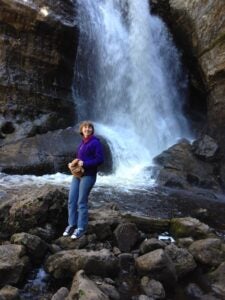August 11, 2014
Summer Experiences: Geology Studies in Theodore Roosevelt National Park
By: Lillian Howie, incoming freshman, intended geology major
 As an incoming geology major, I’m always looking for opportunities to get involved in the field and learn new things about the environment. This summer, I had the privilege of accompanying my family on a tour around the Great Lakes. We traveled as far west as the North Dakota Badlands and then circled through Manitoba and Ontario to view sites on the lakes, focusing on National Parks.
As an incoming geology major, I’m always looking for opportunities to get involved in the field and learn new things about the environment. This summer, I had the privilege of accompanying my family on a tour around the Great Lakes. We traveled as far west as the North Dakota Badlands and then circled through Manitoba and Ontario to view sites on the lakes, focusing on National Parks.
The U.S. National Park system preserves many special geological sites, such as Pictured Rocks National Lakeshore, where minerals in groundwater paint the lakeside rocks vibrant colors, Isle Royale National Park, where Lake Superior’s reefs pose a menacing threat to traversing ships, and Theodore Roosevelt National Park, where underground coal veins, exposed by erosion, can catch fire and burn for decades.
Theodore Roosevelt National Park was actually the highlight of my trip. The park itself is a pristine wilderness filled with unique plant and animal life and beautiful views of the colorful rock formations. Just outside of the park, however, things are not as pristine. Theodore Roosevelt National Park resides in the Bakken Oil Field, the largest continuous oil field in the world. National Parks magazine reports that there are currently 7,000 active wells in the Bakken formation, and that number is expected to rise exponentially in the next 20 years. Travelling between the three park units, I got the chance to see many of the area’s active oil wells and their consequences: air pollution, increased traffic, and disruption of the landscape. Oil drilling is not permitted inside the park boundaries, but that hasn’t stopped the oil industry from completely surrounding the park, and it’s not easy for visitors to miss.
There obviously would not be such a scramble to harvest the Bakken formation’s oil if there was not a demand for it. Geologists, likewise, are instrumental in the search for energy resources to fuel society’s infrastructure. However, geologists are also the ones who must take into account the environmental impact of harvesting these energy resources. The trick is finding a balance between preserving the landscape for future generations and harvesting resources for the benefit of the current population.
As I learned in my time in Theodore Roosevelt National Park this summer, finding that balance is not easy, nor will it satisfy all involved parties in the end. Environmental activists battle with the oil industry in political debates that can sometimes overshadow what is really at risk. Visiting sites like Theodore Roosevelt National Park help visitors to see more clearly the need for a sustainable approach to harvesting natural resources.
My hope is, with the education I am going to receive at ECU, I can become an educator about these topics. Finding a balance with the natural world is so important, and I want to be able to share my inspiration with others.
Visiting Theodore Roosevelt National Park this summer gave me a renewed enthusiasm for my future goals, and I am so grateful to the Honors College for helping to bring those goals to fruition. If I have the opportunity to return to Theodore Roosevelt National Park as an intern or an employee, I hope to inspire visitors as I have been inspired this summer.
- Categories:
- Brinkley-Lane Scholars
- Honors College
